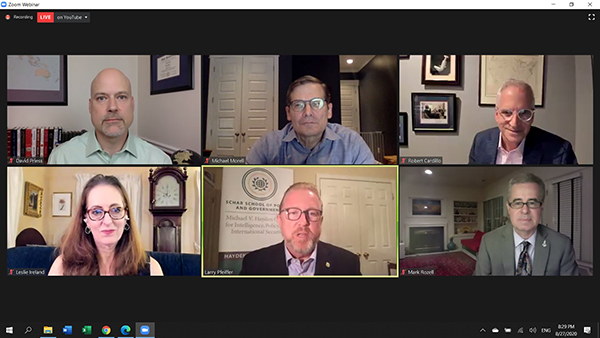In This Story
Originally published on September 1, 2020
An audience of nearly 700 viewers tuned in on August 27 to hear former intelligence leaders describe the history, contents, and future of what is known as the Daily Presidential Brief. As it happens, what may seem like a simple task—delivering an intelligence analysis to White House leadership—is actually rather complex, and has a history all of its own.
The program, called “Good Morning, Mr. President: A Peek Inside the President’s Daily Brief, was co-hosted by the Michael V. Hayden Center for Intelligence, Policy, and International Security at the Schar School and the Lawfare Institute. It was recorded and is available for viewing. The 90-minute discussion was extended by 30 minutes to accommodate questions from viewers.
“It’s important to note for our conversation here tonight, that [earlier] presidents did not receive daily in-person briefings from intelligence officers,” said moderator David Priess, chief operating officer of the Lawfare Institute and author of The President's Book of Secrets: The Untold Story of Intelligence Briefings to America's Presidents. “That really started in the mid-1970s with Gerald Ford, and then with George H.W. Bush to be the first president to take daily briefings for the entire course of his presidency.”
“My story might frighten some, and might give others hope,” said Robert Cardillo at the beginning of his comments. Cardillo, former director of the National Geospatial Intelligence Agency, recounted how he downplayed his report to President Obama about riots in Tunisia as Obama was preparing for a Hawaii vacation. It turned out, the riots were the beginning of the Arab Spring.
Leslie Ireland, former assistant secretary to the Treasury for Intelligence and Analysis, pointed out “there is a dynamic tension between intelligence and policy. Policy sees the world the way it should be, and intelligence sees the world the way it is."
“When I was an analyst, you did not write for the president,” said Michael Morell, former acting director of the CIA and now a Distinguished Visiting Professor at the Schar School. “You wrote for something called the National Intelligence Daily—the NID—and when you dropped off your NID draft you would drop off a copy at the President’s Daily Brief staff, and they would decide if they wanted to turn it into a [briefing].”
That approach, Morell said, “lasted until the mid-1990s, when we went through something called the ‘First Customer’ program, when we turned everything on its head and we said ‘it doesn’t make any sense not to write with the president in mind.’ So, during my entire analytic career I never wrote with the president in mind.”

